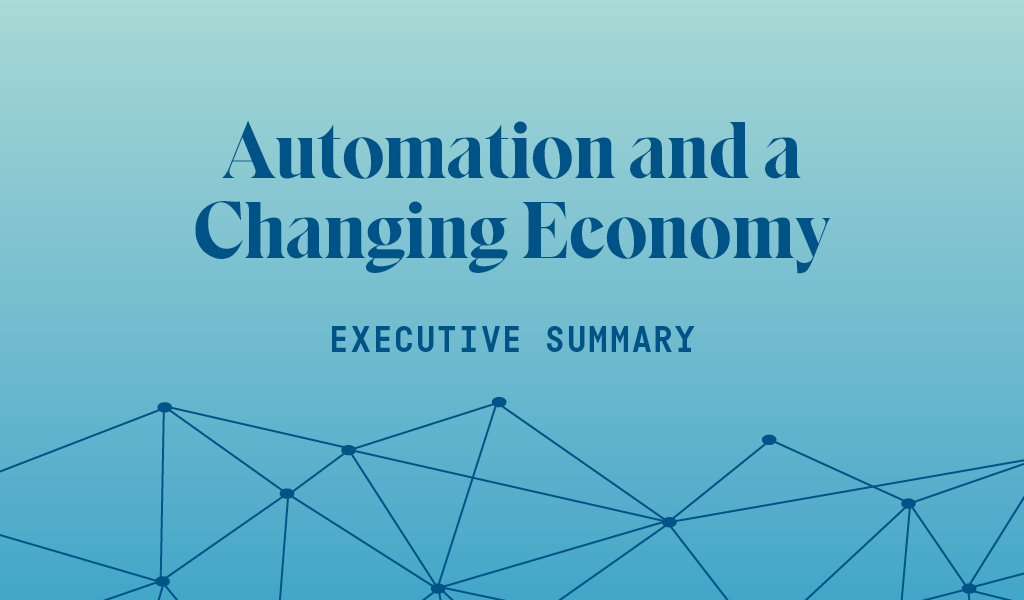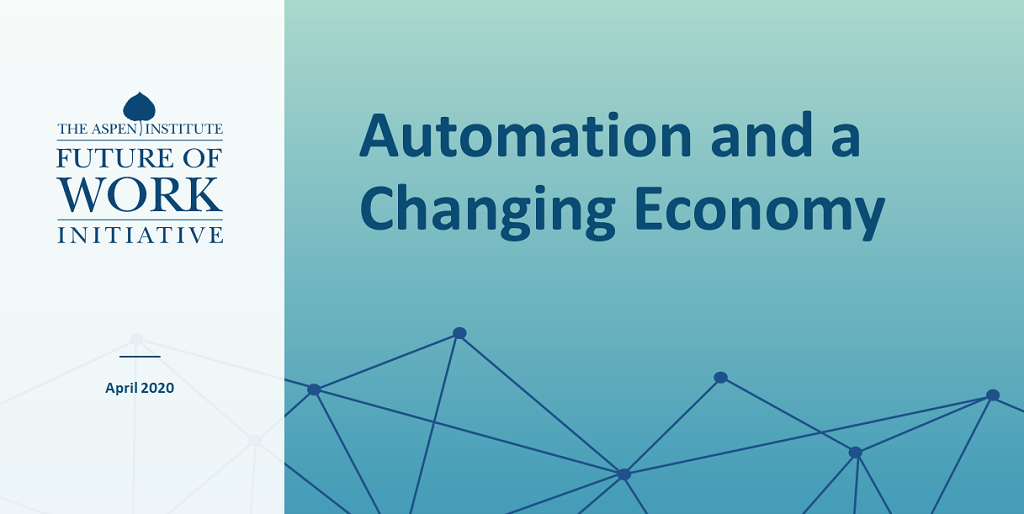Automation and a Changing Economy
Automation is an important ingredient driving economic growth and progress. Automation has enabled us to feed a growing population while allowing workers to transition from subsistence farming to new forms of work. Automation helped moved us from a craft system to mass production, from blue-collar to white-collar to “new collar” work—with better work, higher wages, more jobs, and better living standards.
But without adequate policies and institutions, automation can also have negative effects on individuals and communities. Emerging technologies—including artificial intelligence, machine learning, and advanced robotics—have the potential to automate many tasks currently performed by workers, leading to renewed questions over what the future holds for the American workforce. We must ensure the proper support structures are in place to promote opportunity and prosperity for all.
Automation and a Changing Economy is divided into two sections.
Part I, Automation and a Changing Economy: The Case for Action, explores how automation impacts the economic security and opportunity of the American worker:
While automation boosts economic growth, creates jobs, and improves living standards, it also presents serious challenges for workers and communities.
Based on what we have experienced in the past, automation should continue to be an important driver of growth and job creation, including in new occupations and industries never before imagined. But automation also presents challenges. Many workers will see their jobs change, as tomorrow’s jobs will require different skills. Others will lose their jobs, suffering significant economic and social hardship as they cope not only with income loss, but also with the loss of purpose and identity that work provides. More broadly, without the right set of solutions, automation can increase income inequality, exacerbating current economic, political, geographic, and social divides.
Investments in education, training, and the social safety net, along with a social contract between employers and workers that provided workplace benefits and protections, have helped mitigate automation’s negative impacts in the past.
The U.S. has a long history of new technologies disrupting the labor market, contributing to large structural changes. With the transitions from agriculture to manufacturing, and more recently to a service and knowledge-based economy, policymakers mitigated the severity of technological disruption by creating and expanding policy supports and programs to help workers take advantage of technological progress. Investments in education and worker training, and expansions of the social safety net—combined with a strong social contract between employers and workers that provided access to critical workplace benefits and protections—helped ensure the gains from automation were more broadly shared.
Recent challenges highlight the consequences of limited supports for vulnerable workers.
Recent history has seen a reversal of efforts to support workers through economic disruption. Disinvestment in public and private sector training, a weakened public safety net, and reduced access to workplace benefits and protections have contributed to the slow and painful economic adjustment many workers and communities have experienced in recent decades.
Today’s workers are especially vulnerable to the impacts of automation. Financial insecurity, an aging workforce, and falling geographic mobility, make it difficult for many to retrain and transition to new occupations following displacement.
Artificial intelligence and other new technologies may lead to deeper, faster, broader, and more disruptive automation.
Automation need not be any more disruptive in the future than it has been in the past to warrant increased policy intervention. But there are several reasons to believe that certain converging technologies—particularly artificial intelligence, advanced robotics, machine learning, and expanding computing power and data storage—could lead to increased automation disruption.
- Deeper: Recent advances in artificial learning technologies may dramatically expand the types of tasks that can be automated.
- Faster: As artificial learning technologies enable machines to learn at a faster rate, and as innovation moves from hardware to software, labor market disruptions could occur more quickly.
- Broader: As digital technologies are increasingly incorporated across a broad array of industries and jobs, disruptions may happen simultaneously, leaving few stable occupations for disrupted workers.
- More Disruptive: Recent forms of automation, such as the use of robotics, focus more on replacing labor rather than augmenting it. In addition, automation has increasingly occurred during recessions, making it harder for disrupted workers
to find new jobs.
Part II of this report, Automation and a Changing Economy: Policies for Shared Prosperity, outlines a program to address automation’s challenges and opportunities. The paper calls for an all-of-the-above approach, from targeted interventions to those with systems-level impact; from place-based policies to national-level reforms to social safety net programs. The paper identifies 22 solutions to address four overarching objectives:
I. Encourage Employers to Lead a Human-Centric Approach to Automation
Challenge: Automation changes workforce skill needs, yet employer investment in workforce development has declined.
Solutions:
- 1. Create a Worker Training Tax Credit to encourage business investment in employees.
- 2. Encourage employers and educational institutions to expand apprenticeships.
- 3. Support development of industry and sector partnerships to create regional jobs and career pathways.
Challenge: Employers are making decisions about adopting automation, but may not take into account potential impacts on workers and communities.
Solutions:
- 4. Encourage employers to engage workers in automation decision-making by promoting worker voice.
- 5. Plan ahead to mitigate disruption and manage workforce transition.
- 6. Promote broadly-shared prosperity through worker ownership.
II. Enable Workers to Access Skills Training, Good Jobs, and New Economic Opportunities
Challenge: The labor market is constantly evolving, with automation contributing to changing jobs and skill needs, but supports for worker training and adult education are limited.
Solutions:
- 7. Create worker-owned Lifelong Learning and Training Accounts.
- 8. Reform Pell Grants to include short-term training programs.
- 9. Improve training quality through community colleges investments and income share agreements.
- 10. Increase transparency of training outcomes through better evaluation data.
- 11. Expand access to high quality and cost-saving career counseling.
Challenge: Many workers struggle to make ends meet, and while automation has the potential to improve job quality, it also may lead to more low-wage jobs and greater economic insecurity.
Solutions:
- 12. Raise worker income and promote job quality through wage subsidies and the minimum wage.
- 13. Create a more flexible labor market and promote entrepreneurship.
III. Help People and Communities Recover from Displacements
Challenge: Workers displaced by automation face significant economic challenges.
Solutions:
- 14. Support displaced workers to retrain for in-demand fields.
- 15. Provide wage insurance to older workers.
- 16. Help displaced workers meet the costs associated with finding a new job..
- 17. Modernize Unemployment Insurance to improve coverage and sustainability.
- 18. Reduce stigma associated with career transitions.
Challenge: Communities that are severely impacted by automation require targeted and comprehensive strategies to recover and transition.
Solution:
- 19. Improve efforts to support local economies and promote regional competitiveness.
IV. Understand the Impact of Automation on the Workforce
Challenge: Policymakers, communities, workers, businesses, educators, and other stakeholders struggle to understand how automation is changing the economy because federal, state and local data on the impact of technology on work is inadequate.
Solutions:
- 20. Create new metrics for tracking technological progress and automation.
- 21. Improve occupational projections to better account for automation.
- 22. Develop better data on how local and regional labor markets are changing.
Technology is not destiny—the impact of innovation on the American worker is mediated by policy choices and how institutions, such as employers, worker organizations, nonprofits and philanthropies, respond to these challenges. By helping workers take advantage of new opportunities and assisting workers who are acutely impacted by automation return to stable work, we can promote greater opportunity and broadly shared prosperity for all.


